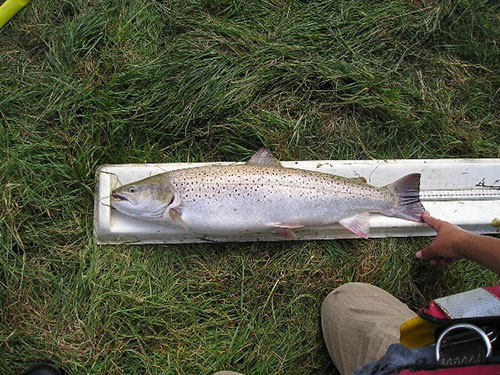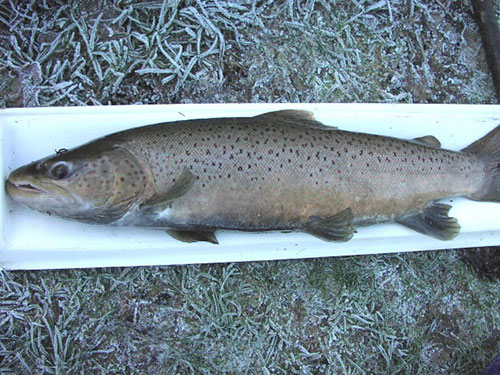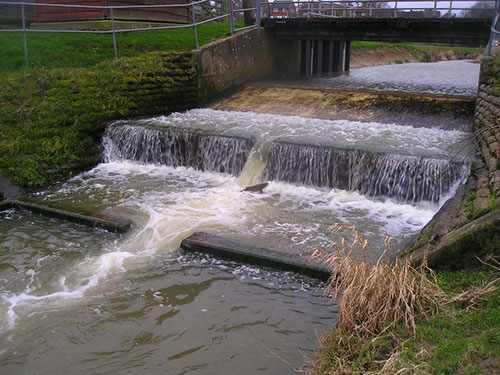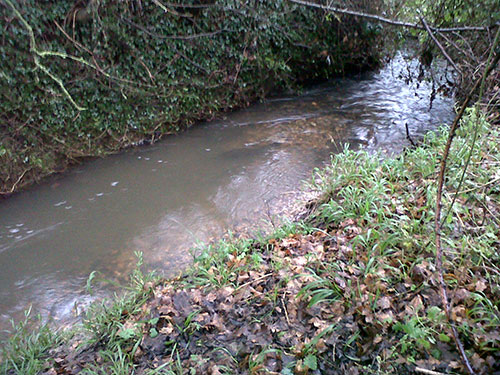


Female (hen) Sea Trout
Photo: Environment Agency

Male (cock) Sea Trout
Photo: Environment Agency

Sea Trout attempting to pass over a weir
Photo: Environment Agency

Hen fish excavating a “redd”
Photo: Environment Agency
As the nights draw in and the temperature drops our activity levels go down too. However in the rivers of Sussex one species is coming into its busiest period. Cold crisp winter days in December give us the opportunity to see possibly our most impressive inhabitant of freshwater, for a short guest appearance.
The Sea Trout though often considered the poor relation of Salmon is an iconic species nonetheless, and Sussex can proudly boast some of the largest in the British Isles. Sea Trout can reach sizes of 5kg or more and perhaps 80cm in length, depending on how long they remain in the food rich environment at sea.
Trout are often considered an indicator species and whilst in freshwater sea trout are very sensitive to poor water quality and low oxygen levels, caused by either pollution, lack of flows and increased water temperature or algal blooms. They prefer faster flowing water for this reason, which also ensures the provision of loose clean gravels that they require to spawn (lay their eggs).
Sea trout migrate (run) the Main Rivers and tributary streams, beginning their journey into freshwater sometimes as early as May or June. Commonly in Sussex catchments there are two peaks in the migration, one in July/August and the other in October/November.
Both male cock fish (above right) and female hen fish (above left) migrate into freshwater each year to spawn, but with numbers usually dominated by hen fish.
On first entering freshwater from the sea fish will be bright silver in colour. As they spend longer in freshwater they will often darken through a pink/bronze colour on the flanks, with some fish being almost black by the end of the winter. Females will be noticeably plumper than males, often with a smaller head, whilst males will develop a hook (kype) on the lower jaw as spawning approaches. This hook develops as they approach spawning time and is believed to be used by the fish in order to fight and see off other males, its size is probably an indication to females of fitness to breed as well.
Fish will gradually progress upstream and may sometimes be seen, clearing obstacles (such as in photo above) when flows allow, until the time comes to spawn
Spawning will often commence in November or December but can be as late as January or Febuary in the New Year. This date can vary dependant on flows and temperature.
Often the presence of such a large fish in relatively small tributary streams allows us the opportunity to see them close up or at least see evidence of their handiwork.
A hen fish will turn on her side and by vigorously beating her tail create a depression by displacing gravel downstream. This nest or “redd” in the substrate will be excavated to a precise depth, which ensures the correct amount of flow is able to pass through the gravel and oxygenate the developing eggs. The picture above shows a fish at work with the light coloured displaced gravel downstream.
Once she is happy with her work she sits in the flow waiting for a male fish to arrive and fertilize her eggs as they are laid. More than one male may be in attendance and they will battle over the hen fish. It is also not uncommon for small resident brown trout males to grasp an opportunity to also fertilize the eggs whilst the far larger male sea trout are distracted. The hen fish will then move a short distance upstream and repeat the process of excavation with this quantity of displaced gravel now covering the eggs. Eggs remain buried in the gravel substrate taking between two and three months to hatch dependant on water temperature.
So now is the time to get out on the river, spot a fish leaping at structures during times of high flow, creep along the small headwater streams and see these magnificent fish going through their courtship, or at the very least see the evidence of their presence by the pits and mounds of freshly turned gravel which contain another generation which will hopefully journey to sea and return again to their place of birth. If you are lucky enough to see one of these fish or evidence of their presence, please record your sighting (ideally with photographs) on iRecord or send them directly to damon.block@environment-agency.gov.uk.
Damon Block
Sussex County Recorder for Freshwater Fish
Every month it is our aim to highlight a species that is “in-season” and, although not necessarily rare or difficult to identify, has been highlighted by our local recording groups as being somewhat under-recorded and for which new records would therefore be welcomed.
If you or your recording group are aware of species such as this then please contact Bob Foreman.